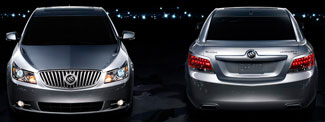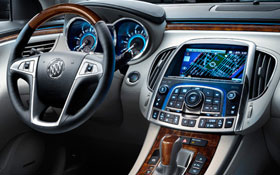2010 Buick LaCrosse
After decades of being too closely associated with older, more conservative buyers, Buick made a breakout in appealing to a younger, more affluent set with the 2008 Enclave crossover utility. The Enclave has been an unqualified success. A second effort is ready with the all-new Lacrosse sedan. While the name is familiar, the car is anything but. It’s a fresh approach with stunning good looks inside and out. Now we’ll see if the Lacrosse can deliver.
Except for the name, the 2010 Buick LaCrosse is all-new. And even that was a point of discussion, since it was first revealed as the Invicta concept at last year’s Beijing Auto Show, and is sold in Canada as the Allure. Its sexy, Asian-penned styling could be mistaken for anything from a Lexus to a Mercedes. Scimitar blade-shaped headlamps flank an Enclave-like waterfall grille. Stylized Buick portholes have migrated from the fenders to the hood.
A high beltline makes room for a deeply sculpted “sweepspear” body line, and provides the greenhouse a low-slung look, even though this LaCrosse is two inches taller.
The less-original rear has lots of chrome- on the license plate header, edging the taillights, and plating the dual exhaust. Wheels come in 17’s, 18’s, or our top-of-the-line CXS Touring’s 19-inch chrome-painted alloys wearing low-profile Eagle RS-A rubber. As part of the ground-up redesign, the outgoing LaCrosse’s pushrod engines are gone, replaced by a trio of twin-cam motors, all with fuel saving direct fuel injection, and a six-speed automatic transmission. Base CX and mid-level CXL share a 3.0-liter V6 with the new Cadillac SRX, churning out 255 horsepower and 217 pound-feet of torque.
 Our LaCrosse CXS sports the same award-winning 3.6-liter V6 that powers the Enclave, rated at 280 horsepower and 259 pound-feet of torque. It will be available in front or all-wheel-drive, a first for a Buick car. Due soon is the Malibu’s frugal Ecotec 2.4-liter four cylinder. This new base is rated at 182 horsepower and 172 pound-feet of torque, with highway fuel economy well into the 30’s.
Our LaCrosse CXS sports the same award-winning 3.6-liter V6 that powers the Enclave, rated at 280 horsepower and 259 pound-feet of torque. It will be available in front or all-wheel-drive, a first for a Buick car. Due soon is the Malibu’s frugal Ecotec 2.4-liter four cylinder. This new base is rated at 182 horsepower and 172 pound-feet of torque, with highway fuel economy well into the 30’s.
But even our CXS 3.6 did pretty good in that area. Government fuel economy ratings are 17 city, 27 highway. We achieved a fine 24.5 mpg in real-world driving with regular gas. With an Energy Impact Score of 16.3 barrels of oil consumed annually, and a carbon footprint of 8.7 tons of CO2 per year, the LaCrosse CXS is on par with its premium rivals. Ditto acceleration: zero to 60 in a respectable 7.5 seconds, with a quarter mile of 15.9 at 90 mph. The big six delivers fine low-end power off the line. Shifts, however, were soft and delayed.
Handling from its new-generation Epsilon platform was actually better than expected. Despite some tendency to understeer, the LaCrosse shifted its weight well along a taut suspension equipped with optional real-time damping. Steering had reassuring heft and a strong self-centering feel. With standard stability and traction control, LaCrosse is much nimbler than its 4065-pound curb weight suggested. Grippy anti-lock disc brakes and a nicely-modulated pedal made for stops averaging a short 125 feet from sixty. Stability was excellent.
 Now for the best part; Invicta’s gorgeous and emotional interior theme was delivered intact for LaCrosse, including elegant door treatments, twin-pod instrument cluster, cool blue lighting, and graceful center console. Beefy seats are wrapped in finely-stitched soft leather with available heat and ventilation. Eight-way power is standard for the driver as is excellent lateral support.
Now for the best part; Invicta’s gorgeous and emotional interior theme was delivered intact for LaCrosse, including elegant door treatments, twin-pod instrument cluster, cool blue lighting, and graceful center console. Beefy seats are wrapped in finely-stitched soft leather with available heat and ventilation. Eight-way power is standard for the driver as is excellent lateral support.
All trims are equipped with satellite radio, automatic climate, and OnStar. Our CXS was loaded up with navigation and rear view camera, oversized sunroof, and head-up display. The split rear seat cushions are a little low, but there is generous legroom, besting the Lexus ES 350 by 4 1/2 inches. There’s an armrest with pass through, an available power rear sunshade, and dual screen DVD. The trunk, however, at 12.8 cubic feet, is smaller and less useable than the ES’.
Base pricing for the LaCrosse is $27,835 for the CX; the CXL starts at $30,395, $32,570 with all-wheel-drive, and the CXS starts at $33,765. In China, where Buick is number one in sales, the venerable brand is revered as a style-setter. With the Enclave, and now the 2010 LaCrosse, that image is starting to take hold in America as well. The “new” General Motors has a lot riding on the success of the LaCrosse, and from where we sit, this ride looks fantastic.
Specifications
- Engine: Cxs 3.6-Liter V6
- Horsepower: 280
- Torque: 259 Lb Feet
- 0-60 MPH: 7.5 Seconds
- 1/4 Mile: 15.9 Seconds @ 90 MPH
- 60-0 MPH: 125 Feet
- EPA: 17 MPG City/ 27 MPG Highway
- Mixed Loop: 24.5 MPG
- Energy Impact: 16.3 Barrels Oil/Yr
- CO2 Emissions: 8.7 Tons/Yr
2025 Volkswagen ID. Buzz
Volkswagen Brings Beetlemania Level Of Excitement To Minivan Segment
The duty of upholding Volkswagen’s heritage has most recently been delegated to small legacy car names like Golf and Jetta. But hold on! A much larger, totally modern take on VW’s classic microbus has just buzzed over the horizon— the all-electric ID. Buzz. It’s been at the top of our minds since we first saw the concept back in 2017. Well, it’s finally here, so let’s get our groove into drive!
This 2025 Volkswagen ID. Buzz has indeed created the most buzz around Volkswagen since the Beetle’s return to the U.S. in the late 1990s. We couldn’t drive it anywhere without drawing a crowd. No wonder, just about everyone has a VW Microbus story to tell, and seeing this reimagined version rolling down the street brings back all those memories.
VW really pulled it off as far as we’re concerned, as it looks great without appearing over the top. All the cues are here: Big VW logo front and center, lots of greenhouse including A-pillar windows and mini sliders for the second-row passengers, D-pillar air vents, and two-tone wheels. And while its appearance may be pure retro, its drivetrain is far from it, as the ID. Buzz is all-electric, and unlike the new Beetle, the Buzz does retain the original Microbus’ rear-drive architecture.
Powering those rear wheels is a 210-kW motor drawing juice from a 91-kWh battery for a range of 234 miles; 200-kW max charging will get you to 80% in about 26 minutes. Buyers can add another small 80-kW motor up front for 4motion all-wheel-drive and an increase of total output from 282 to 335 horsepower with a combined 512 lb-ft of torque. It uses the same battery, but range estimates drop just slightly to 231 miles. But while those numbers are modest, we also found them to be quite conservative, as we observed as many as 287 miles available in our all-wheel-drive tester’s gauge display and were on pace for 273 miles in our driving loop.
One throwback theme that may be a turnoff to some is that it’s quite a step up into the Buzz’s front seats, but there’s certainly a commanding view of the road once you climb in. Second row seating can be either a three-place bench or a pair of captain’s chairs, so there’s generous room for seven or six passengers. The captain’s chairs in our Pro S Plus offer good support and very easy access to the third row.
Lots of flexibility too with the option to simply fold the seats or remove them altogether.
With the sliding side doors and a wide opening rear hatch, there’s plenty of access for loading big sport utility amounts of cargo. Lots of flexibility too with the option to simply fold the seats or remove them altogether, and the ability to create a full-length flat floor with a rear cargo shelf that covers some handy removable storage bins. There’s 18.6 cubic-feet of space behind the third row, 75.5 behind the second, and a max of 145.5. That’s more than a Chevrolet Tahoe. For smaller items, there are lots of cubbies throughout the cabin, along with a standard Buzz Box that can be moved to multiple locations.
With a design that prioritizes retro form and modern function over aero efficiency, the 4motion equipped ID. Buzz earns a Fair efficiency rating, using 42-kWh of electricity per 100 miles, and we weren’t sure what to expect at our Mason Dixon test track.
What we found was great torque off the line and drama free launches to 60 in just 5.3 seconds. It was very stable at speed and power delivery stayed steady most of the way down the track until we reached about 90 mph, when it began to taper off just before we finished the quarter-mile in 14.0 seconds flat at 97 mph.
With 1,200-lbs. of battery weight nestled in its 127.5-inch wheelbase, the Buzz felt planted to the pavement through our handling course. There was quite a bit of body roll to deal with, but surprisingly little understeer. In panic braking runs, pedal response was inconsistent, feeling soft at times, pushing back hard at others; but through it all, results were quite good, stopping from 60 in an average of just 108 feet.
Three interior themes are available, this Dune is the brightest, featuring coastal inspired wood optic dash décor, “gray and clay” leatherette surfaces, and a high-mounted central 12.9-inch touchscreen. Pricing starts with a rear-wheel-drive Pro S at $61,545; this Pro S Plus begins at $65,045, add another $4,500 for 4motion, which brings a few extra features along with all-wheel drive.
Retro design with old-school VW charm, modern EV drivetrain, big SUV capacity merged with minivan flexibility; it all comes together in this 2025 Volkswagen ID. Buzz. It’s easily one of the coolest rides of the year and one that will likely keep Volkswagen dealers buzzing for years to come, and that’s something no other people and things mover can say.
Specifications
As Tested
- Motor Setup: Dual-Motor AWD
- Battery Size: 91-kWh
- Horsepower: 335
- Torque: 512 lb-ft
- EPA Range: 231 miles
- 0-60 mph: 5.3 seconds
- 1/4 Mile: 14.0 seconds at 97 mph
- Braking, 60-0: 108 feet
- MW Test Loop: ~ 273 miles













































